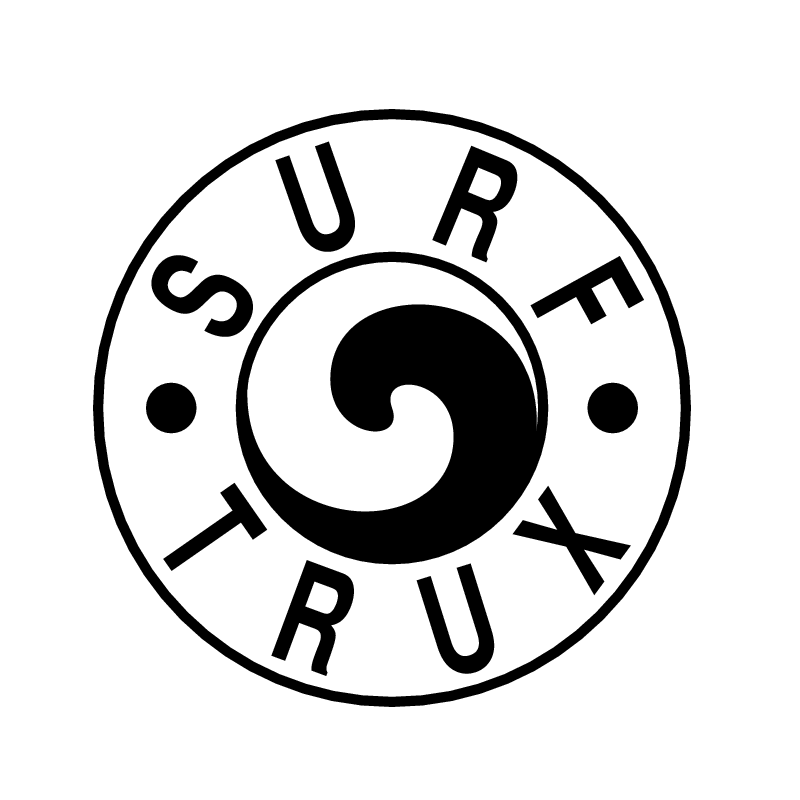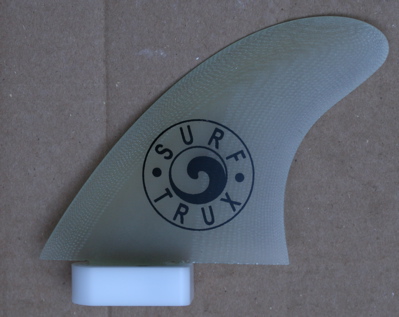
How is the ride different from a thruster? The thruster is
the most similar fin system to SurfTrux, with the same fin sizes
and positions. On a turn, the board with Trux is slightly looser
with similar or slightly better thrust, and noticeably better
release in the second half of the turn. These changes occur
because the outside rail fin toes out. When you are in between
turns, if your weight is very far back it feels identical to a
thruster. If you lean forward when you are not turning hard, the
board will accelerate quite noticeably.
Is it hard to install? The installation follows one surf
industry standard method. Position the box with a template. Route
a hole. Cast the box in the hole with resin. Glass over the top
of the box. Standard glass shop tools are all that is required.
Can I get other fins made for SurfTrux? We can offer fins
from Rainbow's catalog through Rainbow, the turnaround is not
fast and they are somewhat costly. In the future we may offer a
few different templates. But the standard template is in stock
and almost everyone is happy with it.
Can you ship to [insert foreign surfing country here] We
accept payment by check or Paypal and will ship to any USA
location. Hopefully we will open international markets soon but
not yet.
You seem to be advertising a better fin system performance
than the other fin companies. If it works so well why didn't they
come up with it? Imagine a surfer who is also a PhD engineer
with the mechanical skills of a machinist and full access to a
machine shop. He builds a rotating single fin in early 2004.
Breaks it. Re-designs it. Builds another. Too heavy. Builds
another. It is light enough and doesn't break. Goes through
several dozen fin template and foils. Tests it. His competition
friends tell him there are yet further things to fix. He fixes it
and gives them more designs to ride. They no longer have any
consistent negative feedback. The beta tests go out, and more,
mostly minor, tweaks in the design are incorporated. After all
that, the three fin tests come out in early 2005. It is
different. The three fin system needs a rotating lockout so fins
cannot toe out too much. The rear fin needs to be fixed. The
best fin templates are different. Every detail needs to be dialed
in, all over again. Then, it works well. That gets us to where
we are today. This is NOT an idea birthed from the surf industry.
It is a radically different approach to how fins and surfboards
interact.
Isn't this just a glorified flex fin? SurfTrux operate by
holding the fins at the best positions when you turn, and letting
them rotate to reduce drag at other times. There is no storage of
energy and release like you get in a flex fin. Qualitatitvely it
does not feel like a flex fin.
Why isn't [name your favorite pro] riding them? The best
surfers who have ridden SurfTrux have all noticed the performance
benefits it provides. More will ride it with time. We are in no
hurry and are in fact confident than SurfTrux will win the
support of all surfers who ride it long enough to get through its
learning curve. It is particularly tough for a very good surfer
to put their weight forward between turns to speed the board up -
because all their years of training tell them that doing that on
a thruster will slow it down!
Where should I position the fins for SurfTrux? Use
standard thruster positions.
I don't feel like the thruster has a lot of drag! Every
surfer who rides a thruster knows that if the waves are too
small, a thruster is not the best tool. To make it work well, the
rider's weight must be far enough rearward. On small waves, this
means you need to keep the nose up to make the fins work.
However, nose-down is lower in drag. This combination makes
thrusters bog in small waves. SurfTrux will fly through the same
conditions if the surfer rides nose-down in between turns. On
bigger waves there is enough wave energy to allow the rider to
keep his weight rearward more of the time, and the advantages of
SurfTrux diminish. On waves head high or smaller, the advantage
is substantial, but it often takes more than 10 sessions to get
fully accustomed to the surfing style that will take advantage of
SurfTrux.
Can I feel the fins moving? No. We engineered the boxes so
that you cannot feel where the fins are at any time, you can only
notice the changes in drag and drive.
It must weigh a lot! Installed, the weight is comparable
to other fin systems. Our fin tab is smaller, which reduces
weight. Our box is slightly heavier, which makes it back up.
The box is 2.25" long by
1.45" by 0.71" deep. Standard finboxes are over 4 inches long and
0.75" deep or deeper, and somewhat less wide. The fins are
standard glass fins. Our installation also minimizes the use of
resin which further keeps the overall weight down after install.
I bet you need to route a hole too deep for the rails on a
competition board The finboxes are less deep than the two
most common finboxes used in competition. Our method of holding
the fin in the box lets us use a shorter fin tab without
compromising fin strength. The hole is only 0.71" deep, which is
not even as deep at the fins of competitors much less the boxes!
It is probably only good for kooks. SurfTrux complements
vert surfing better than any other fin system bar none. It
provides all the advantages of a thruster, and then some.
What do the fins and boxes look like?



